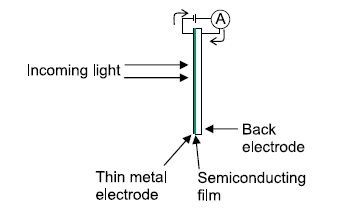Optipedia • SPIE Press books opened for your reference.
Photon Detectors
Excerpt from Field Guide to Spectroscopy
Photon detectors count photons of light. A photon detector has some surface that absorbs photons and produces some effect (current, voltage) proportional to the number of photons absorbed.

A photovoltaic cell consists of a layer of semiconductor (like selenium, Hg-Cd-Te, Cu2O, etc.) sandwiched between two metallic electrodes, with the exposed electrode thin enough to be transparent. Photons of light are absorbed by the semiconductor, forming electrons and holes that create a current proportional to the number of photons absorbed.

A phototube uses the photoelectric effect to generate a current from absorbed light. Light is absorbed by a metallic surface with a low work function. Electrons are emitted and attracted to a positively biased anode. Electronics measure the current, which is proportional to the number of photons absorbed.
D. W. Ball, Field Guide to Spectroscopy, SPIE Press, Bellingham, WA (2006).
View SPIE terms of use.

